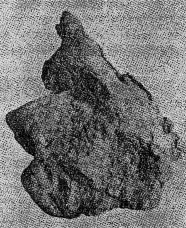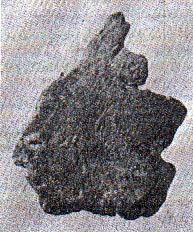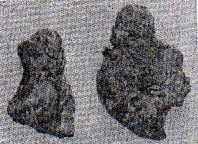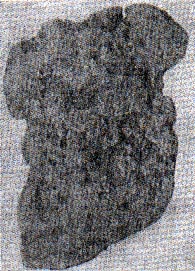
|
|
Volume 9, pages 23-26, 1924 SOME UNUSUAL SPECIMENS OF "FLOAT" COPPER1 EDWARD H. KRAUS, University of Michigan In August 1923, the Mineralogical Laboratory of the University of Michigan received a large mass of native copper from the copper district in the northern part of Michigan which proved not only of interest to mineralogists but also of great importance to American archaeologists. The specimen was obtained through the efforts of Dr. L. L. Hubbard of Houghton, Michigan, formerly state geologist of Michigan and latterly, for many years, a regent of the University. It was found as float material, that is, loose in the soil and hence is referred to as "float" copper. The specimen was uncovered about two years ago by Mr. John Gaspardo while plowing on his farm located about two and a quarter miles in a northwesterly direction from the Franklin Mine, in Houghton County, Michigan. When found it was covered by about six inches of soil. It is thirty-two inches wide and forty-two inches long. Its greatest thickness is about six inches. It weighs 483 pounds. When the specimen was received at the laboratory it was at once observed that the side then exposed to view not only showed all the characteristics of float copper, which had long been subjected to the oxidizing and hydrating agencies of the soil, but also that it had been well glaciated. The glaciation is clearly shown by the striations which extend lengthwise across the specimen. They are especially well seen in what will be called the upper portion of the specimen. Furthermore, the edges of what may be termed the lower portion are well rounded while the upper edges are not. In this way the direction of the ice movement across the slab of copper is clearly indicated, namely from the lower to the upper portion. The glaciation antedated exposure to oxidation and hydration in the soil for the striations underlie the cuprite and malachite crusts, which were undoubtedly formed after the specimen became lodged in the soil where it was found. As soon as evidences of glaciation were observed it was at once decided to have the specimen photographed from various angles in order to show the glaciation to the best advantage. In developing one of the negatives it was observed that the specimen, which is quite large and on account of its weight not easily handled and therefore had been studied at very close range while it was lying flat on the floor, was actually in the form of a large Indian head. The outline is distinctly that of an Indian chieftain with headdress, (Fig. 2).
FIG. 1. FIG. 2. That this specimen of native copper was actually worked by primitive man is clearly seen on the reverse side (Fig. 1). Here it is obvious that the original edges have been pounded over, especially on the nose, forehead, and certain portions of the headgear. This, of course, was done to improve the outline. Undoubtedly the original shape of the specimen attracted the attention of the Indians who saw in it the rough outline of a chieftain's head with elaborate head-dress but not being entirely satisfied with its appearance improved it by turning over the edges, as indicated above. The position and unusual sharpness of the eye slit clearly indicate that it is also the work of man. It may be that a natural depression or small crack served as a basis for the slit. The well preserved character and prominence of the slit are rather conclusive evidence that this work could not have been done in pre-glacial times for glaciation would obviously have obliterated much of the opening. At any rate the slit would not be as well defined as it is. The accentuating of the profile is, therefore, clearly post-glacial. For reasons given above, the movement of the ice was undoubtedly from the lower, or chin portion, across the face toward the top and from the lower, or chin portion, across the face toward the upper part of the head and headgear.
Figs. 3 and 4 Fig. 5 It is suggested that this unusual specimen of native copper, after having been fashioned as described, was either set up in the wigwam of the chieftain of a prehistoric tribe inhabiting the copper district of Michigan, or it may have been mounted as a totem in some prominent place in the tribal village. Later on, when the tribe moved away, the specimen was left behind on account of its weight, and in due time became dislodged and sank into the soil where it was found about two years ago. In confirmation of the suggestion that the locality, from which this Indian head was obtained, was formerly the scene of a prehistoric village, it is of interest to report that in October 1923, four other but very much smaller specimens of native copper, also "float" material, were obtained from the same place. These specimens are in the shape of implements. One of them is an axe head or tomahawk (Fig. 4). It is eight and a quarter inches long and five and a half inches in the widest part. Another specimen apparently was used as a hammer head. It is six and a half inches long and three and a half inches at the base (Fig. 3). A third specimen was probably a primitive hoe or perhaps a crude plowshare (Fig. 5). Its average length is about eight inches. It measures six inches in the widest portion and tapers to a blunt point. Near the top it has been notched at both edges apparently for the purpose of tying it to a handle or some support. . The fourth specimen is circular in outline, rather flat on one side and more convex on the other (Fig. 6). It measures nine inches in diameter and has a maximum thickness of two and a quarter inches. The edge is partly blunt and partly quite sharp. The use to which this implement was put is not clear but it is thought that it may have been employed to crush grain by rocking it back and forth as is done at present by some primitive tribes in other parts of the world.
Fig. 6. The first three implements referred to are rather rough. They have not been well pounded out. Hence they are very crude when compared with many of the copper implements previously found which have a much more finished appearance. It is suggested that these specimens represent either partially finished products or, what to my mind appears to be more probable, very early attempts on the part of primitive man in the Lake Superior district to shape native copper into implement forms. 1 Read before the Mineralogical Society of America at the Washington meeting, December 29, 1923. [var:'startyear'='1924'] [Include:'footer.htm'] |




